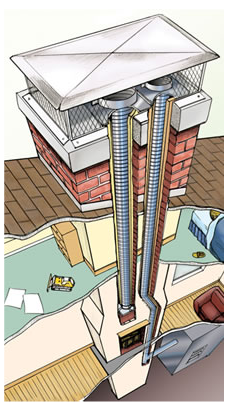Chimney Liner Basics
 About 75 years ago in the U.S., tests by the National Bureau for Standards (NBS) revealed that a chimney without a lining is extremely dangerous. Researchers expressed their conclusion that it is practically criminal to build a chimney without a lining because it is such an unsafe practice. Chimney liners have been building code requirements since the early 1900s; but there are, alarmingly, some modern builders who ignore standard practices and omit a chimney liner. Since the beginning, clay tiles have universally been the liner of choice in new chimneys. Clay tile liners are economical and typically last for about 50 years. No matter what type of liner material you chose, it’s important to understand that the chimney liner is the most important component of the entire chimney system.
About 75 years ago in the U.S., tests by the National Bureau for Standards (NBS) revealed that a chimney without a lining is extremely dangerous. Researchers expressed their conclusion that it is practically criminal to build a chimney without a lining because it is such an unsafe practice. Chimney liners have been building code requirements since the early 1900s; but there are, alarmingly, some modern builders who ignore standard practices and omit a chimney liner. Since the beginning, clay tiles have universally been the liner of choice in new chimneys. Clay tile liners are economical and typically last for about 50 years. No matter what type of liner material you chose, it’s important to understand that the chimney liner is the most important component of the entire chimney system.
Many old homes still have unlined chimneys; what builders usually did in the old chimneys was to parge the flues with mortar. Masonry joints and parging in these chimneys are eroded by moisture, time, and combustion gases.
What is the Function of Chimney Liners?
Chimney liners basically serve three functions:
- The chimney liner prevents heat inside the chimney from transferring to adjacent combustibles. The NBS tested unlined chimneys and found that in just 3.5 hours, nearby woodwork caught fire from the chimneys’ extreme temperatures.
- The chimney masonry is protected from corrosive combustion byproducts by chimney liners. The life of a chimney is reduced when the brick and mortar are penetrated by flue gases. The mortar joints of the chimney rapidly deteriorate when exposed to the acidic properties of the combustion gases. The corrosion of mortar joints results in dangerous gases leaking into the home, including deadly carbon monoxide.
- When appliances use the chimney for venting, the chimney liners need to be the size recommended by manufacturers. Proper performance of modern gas, oil, and wood stoves depends upon the flue being the correct diameter. In addition to removing combustion by-products out of the home, the chimney flue helps to ensure that an adequate draft is generated. If the liner is the wrong size, the result can be production of carbon monoxide and an excessive buildup of creosote.
When is Chimney Relining Needed?
There are several reasons a chimney may need to be relined. It could be because there is no liner, the chimney lining is defective, or the original clay tiles have deteriorated and no longer provide the needed protection to combustible parts of the home. Even a small crack in a liner creates the potential for a house fire.
What are the Options for Chimney Liners?
The primary types of chimney liners that are available are clay tile, metal, and cast-in-place.
 A clay liner is the best choice when a chimney is being built, but it is not cost-effective to re-line with clay tile because the task requires intense labor. In order to remove damaged tiles and install new ones, it’s typically necessary to break out portions of the chimney every few vertical feet.
A clay liner is the best choice when a chimney is being built, but it is not cost-effective to re-line with clay tile because the task requires intense labor. In order to remove damaged tiles and install new ones, it’s typically necessary to break out portions of the chimney every few vertical feet.- Metal chimney liners are the preferred choice. Stainless steel liners are suitable for all fuel types – wood, gas, and oil. Stainless steel usually carries a lifetime warranty. Aluminum is a less expensive option but can only be used with some types of medium efficiency gas appliances. It is recommended that insulation be installed under metal liners, for performance and safety reasons.
- Cast-in-place chimney liners are lightweight cement-like products that are poured in the chimney passageway along the outer walls. There are several benefits to this type of chimney liner. First, they provide excellent insulation that is suitable for all fuel types. Second, cast-in-place chimney liners improve the structural integrity of a chimney. Third, fireplaces burn cleaner, which means there is less of a creosote buildup.
Contact our chimney professionals for an annual inspection, which will include a careful check of the condition of your chimney flue lining.





